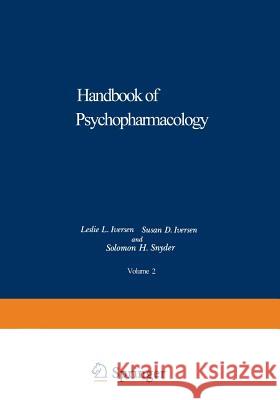Principles of Receptor Research » książka



Principles of Receptor Research
ISBN-13: 9781468431704 / Angielski / Miękka / 2012 / 288 str.
Principles of Receptor Research
ISBN-13: 9781468431704 / Angielski / Miękka / 2012 / 288 str.
(netto: 192,11 VAT: 5%)
Najniższa cena z 30 dni: 192,74
ok. 22 dni roboczych.
Darmowa dostawa!
1 Blood-Brain Barrier: Techniques for the Intracerebral Administration of Drugs.- 1. Introduction.- 2. Characteristics of the Blood-Brain Barrier.- 2.1. Specific Activity of the Blood-Brain Barrier.- 2.2. Breakdown of the Blood-Brain Barrier.- 2.3. The Brain-CSF Barrier.- 3. Bypassing the Blood-Brain Barrier: Principles.- 4. Pharmacological Approach to the Internal or External Surface of the Brain.- 4.1. Drugs Applied to the Surface of the Cortex.- 4.2. Administration of a Drug into the Cerebral Ventricles.- 4.3. Perfusion of Brain Surfaces.- 5. Drugs Administered to the Brain Parenchyma.- 5.1. Injection of Solution.- 5.2. Depositing a Chemical in Crystalline Form.- 5.3. Isolated Perfusion with Push-Pull Cannulae.- 6. Concluding Comment.- 7. References.- 2 Microiontophoretic Application of Drugs onto Single Neurons.- 1. Introduction.- 2. Basic Principles.- 2.1. Spontaneous Efflux of Active Material from Microelectrodes.- 2.2. Release of Ionized Substances During Passage of Iontophoretic Current.- 2.3. Electro-osmosis.- 2.4. Microinjection.- 3. Dispersal of Iontophoretically Applied Substances Within the Brain.- 3.1. Theoretical Curves Based on Models of Diffusion.- 3.2. Tissue Uptake Mechanisms and Drug Redistribution.- 4. Conclusions.- 5. References.- 3 Electrical Recording of Brain Activity: The EEG and Its Value in Assessing Drug Effects.- 1. Introduction.- 2. Selection of Animal Species.- 3. Acute Experiments.- 4. Chronic Implantation of Electrodes.- 5. Recording Procedures.- 5.1. Experiments in Animals with Chronic Implants.- 5.2. Human Studies.- 5.3. Derivations.- 5.4. Amplifiers.- 5.5. Paper Records.- 5.6. Magnetic Tape Recording.- 6. Methods of Analyzing and Quantifying the EEG.- 6.1. Hand Analysis.- 6.2. Integration.- 6.3. Frequency Analysis.- 6.4. Spectral Analysis.- 6.5. Correlation Procedures.- 7. Sensory Evoked Response Analysis.- 7.1. Visual Evoked Responses.- 7.2. Somatosensory Evoked Responses.- 7.3. Auditory Evoked Responses.- 8. Focal Electrical Stimulation.- 9. Electrogenesis of the EEG and Evoked Potentials.- 10. Assessment of Alertness, Sedation, and the Stages of Sleep.- 11. Study of Sleep Patterns.- 12. Abnormal EEG Records.- 12.1. Normal Rhythms Occurring Abnormally.- 12.2. Nonepileptic Abnormal Rhythms.- 12.3. Epileptic Features.- 13. Transmitters and EEG Changes.- 13.1. Acetylcholine.- 13.2. Catecholamines.- 13.3. 5-Hydroxytryptamine.- 13.4. ?-Aminobutyric Acid.- 14. Uses and Limitations of Macroelectrode Recordings.- 15. References.- 4 Neuropharmacological Responses from Nerve Cells in Tissue Culture.- 1. Introduction.- 2. Muscle.- 3. Continuous Cell Lines.- 4. Glia.- 5. Explants.- 6. Dissociated Primary Cell Cultures.- 7. Discussion.- 8. References.- 5 Biochemical Identification of Membrane Receptors: Principles and Techniques.- 1. Introduction.- 2. Properties of Receptor Interactions and Technical Considerations.- 2.1. Number and Affinity of Membrane Receptors.- 2.2. Preparation of Radioactive Ligand Derivatives.- 2.3. Rates of Association and Dissociation.- 2.4. Competitive Antagonists as Tools for Binding Studies.- 2.5. The Problem of Specific vs. Nonspecific Binding.- 2.6. Methods of Obtaining Binding Data.- 2.7. Measurements on Solubilized Receptors.- 2.8. Membrane Receptors and Proteolytic Agents.- 2.9. Comparative Studies of Ligand-Membrane Interactions.- 2.10. Other Methods for the Study of Ligand-Receptor Interactions.- 2.11. Mathematical Analysis of Binding Data.- 3. Examples of Studies on Hormone-Membrane Receptor Interactions.- 3.1. Insulin-Receptor Interaction in Fat and Liver Cells.- 3.2. Insulin Receptors in Human Lymphocytes and Fibroblasts.- 3.3. Insulin-like Activity and Binding of Plant Lectins.- 3.4. Glucagon Binding and Action in Liver Membranes.- 3.5. Epidermal Growth Factor Receptors in Human Fibroblasts.- 3.6. Catecholamine Binding and ?-Adrenergic Receptors.- 3.7. Macromolecular Hormone Derivatives and Plasma Membrane Receptors.- 4. Conclusions.- 5. References.- 6 Structure-Activity Relations for Neurotransmitter Receptor Agonists and Antagonists.- 1. Introduction.- 2. Norepinephrine.- 2.1. Peripheral Nervous System.- 2.2. Adrenergic Receptors in the CNS.- 2.3. Possible Modes of Action.- 2.4. Crystallographic, NMR, and Theoretical Studies of the Conformation of NE.- 3. Dopamine.- 3.1. Dopamine Receptors in the Mammalian Peripheral and Central Nervous Systems.- 3.2 Dopamine Receptors in Invertebrates.- 3.3. Structure-Activity Relationships of DA Receptor Agonists and Antagonists in the Mammalian Peripheral Nervous System.- 3.4. Structure-Activity Relationships of DA Receptor Agonists and Antagonists in Invertebrates.- 3.5. DA Receptor Agonists and Antagonists in the Mammalian CNS.- 4. 5-Hydroxytryptamine.- 4.1. 5-HT Receptors in the Mammalian Peripheral Nervous System and Other Preparations.- 4.2. Structure-Activity Relationships of 5-HT Agonists.- 4.3. 5-HT Antagonists.- 5. Acetylcholine.- 5.1. Muscarinic Actions of ACh.- 5.2. Nicotinic Actions of ACh.- 5.3. Cholinergic Agonists.- 5.4. Antagonists at the Nicotinic Receptor.- 5.5. Possible Modes of Action.- 5.6. NMR Studies.- 5.7. Theoretical Studies.- 5.8. X-Ray Crystallographic Studies.- 6. Histamine.- 6.1. Physiological Effects.- 6.2. Histamine Receptors.- 6.3. Structure-Activity Relationships.- 6.4. Structure-Activity Relationships for Histamine-like Activity on Gastric Acid Secretion and Inhibition of the Rat Uterus.- 6.5. Structure-Activity Relationships of Antihistamines.- 6.6. Possible Mechanisms of Action.- 7. References.- 7 Denervation Supersensitivity.- 1. Introduction.- 2. Quantitative Methods in the Study of Supersensitivity.- 3. Surgical and Pharmacological Denervation.- 4. Supersensitivity After Denervation of Sympathetically Innervated Organs.- 4.1. Events During Degeneration of Adrenergic Nerves.- 4.2. Prejunctional Component of Denervation Supersensitivity.- 4.3. Postjunctional Component of Denervation Supersensitivity.- 5. Supersensitivity After Denervation of Cholinergically Innervated Organs.- 5.1. Events During Degeneration of Cholinergic Nerves.- 5.2. Time Course of Development of Supersensitivity and Pharmacological Characteristics.- 6. Supersensitivity in the Central Nervous System.- 7. Clinical Implications of Supersensitivity and Subsensitivity.- 8. References.
1997-2026 DolnySlask.com Agencja Internetowa
KrainaKsiazek.PL - Księgarnia Internetowa









